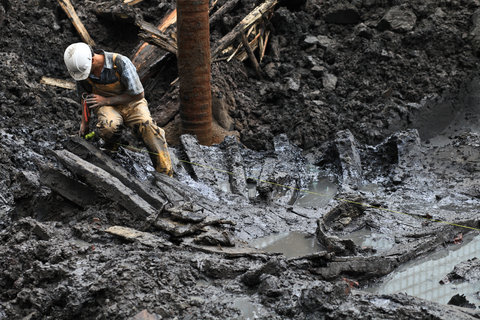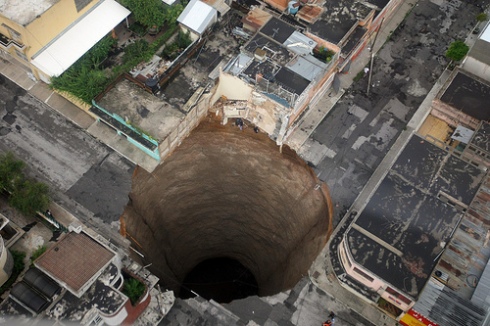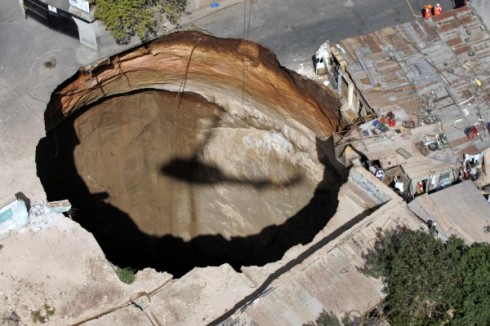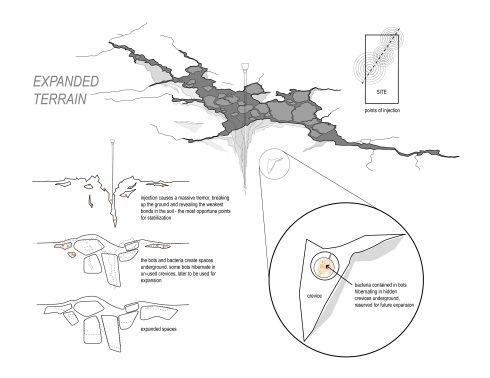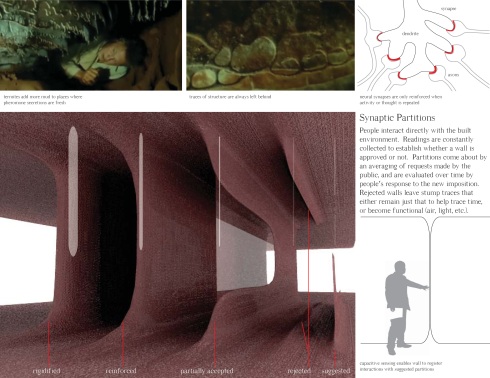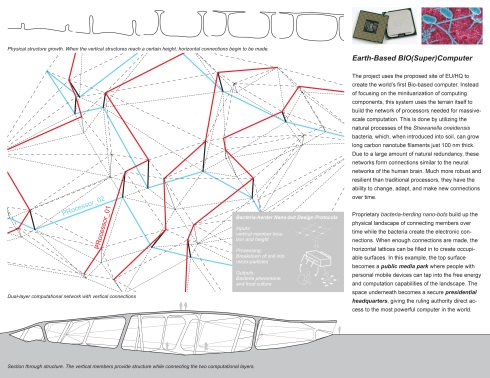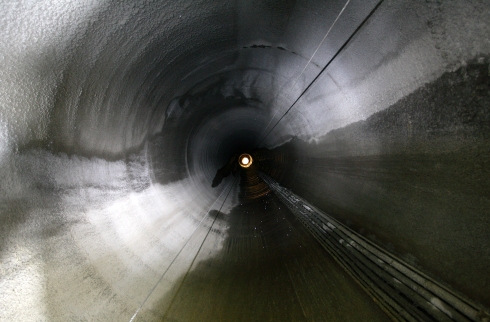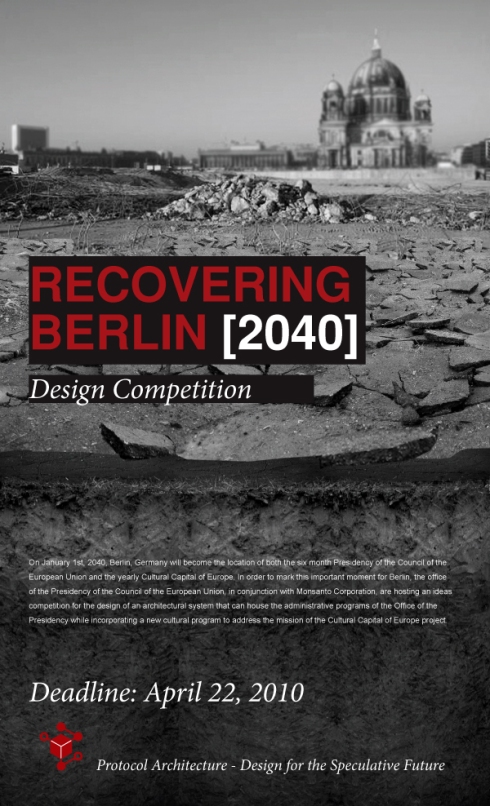An 18th century ship skeleton was unearthed in the hole that is Ground Zero. What else gets used as infill aside from old ships? Yet time is catching up fast with this relic. With it only recently being exposed to the air, the wood is disintegrating fast.
2010, aftermath of tropical storm Agatha
2007
Sink holes in Guatemala keep turning up in urban locations, taking lives and disrupting the operation of the city. There is still no clear explanation for these holes or any prediction of where others might emerge. This looks like a job for Transparent Earth, or what they’re calling “planet hacking.” One can imagine an architectural competition to program such a space. Rock climbers get priority.
On the note of embedding secrets in the ground, there comes again the question of the timescale that different places can manage. Things change a lot faster in New York than they do in Antarctica, let’s say. And as noted in Into Eternity (see fellow Protocol Architecture critic Jamie Kruse’s article) time is even slower below ground than above it. And yet, different undergrounds have different time scales just like different cities do. The earth in Japan is too seismic, and the earth in Guatemala, we are starting to notice, is also unpredictable. The bedrock in Finland is a lot more dependable over the scale of 10,000s of years. Can someone map the geological activity and variability throughout the world? (this is a request, not a wondering) Now, the fact Finland is rising to the occasion of addressing its nuclear waste issue may or may not be due to their fortunate bedrock situation. What’s more interesting is whether there might be an economy for this type of real estate. Taking care of one’s waste doesn’t sound as sexy as the reasons for such a market given by Protocol Architecture’s final proposal for Berlin’s future (final images will be posted soon).
Our competition officially closed on April 22nd, 2010. On April 23rd, Protocol Architecture held a jury review at Columbia University. Jurors in attendance were Mark Collins of Proxy, Ed Keller of a|Um, and Geoff Manaugh of BLDGBLOG.
Several other jurors have responded to the entries remotely, including:
Kristen Alvanson, artist
Juan Azulay, Matter Management
Eric Ellingsen, Species of Space and Olafur Eliasson Workshop
Jamie Kruse, smudge studio
Reza Negarestani, author of Cyclonopedia
Roland Snooks, Kokkugia
You can read their comments here. And see videos from the jury review at Columbia here.
Based on the combined results, Protocol Architecture would like to announce the winning entries of the Recovering Berlin [2040] competition.
Entry 1: Expanded Terrain
Entry 12: Synaptic Partitions
Entry 16: Earth-Based BIO (Super) Computer
Thank you to all participants and jurors. Check back for future projects from Protocol Architecture.
What will survive into the future? Which State? Which language? Into Eternity follows the spearheads of this discussion, the Finns, who deal with it by avoiding it altogether. The problem of handling nuclear waste responsibly (a statement which proves to be oximoronic) is so pressing that it seems the only way to resolve it is to release it from its problematization and simply take action. A series of interviews with the private company that is undertaking the 100 year process of depositing Finland’s (only Finland’s) nuclear waste in the Onkalo (literally “hiding place”) displays one of the most provocative collection of blank faces. The repository must store and conceal the material from any disturbance for at least 100,000 years (that number, while inconceivable in itself, is smaller by a factor of 10 than the American one). The curiosity of mankind and the inconsistency of civilizations over time prove to be more of a problem than finding a hiding place in the earth. The scale of time above ground is so fast for such an endeavor that there’s a certain increase in assurance in underground deposits.
In a time when architects are just as concerned with information technologies as they are in structures, this film finds its relevance in showing how the project of sustaining a material condition is a lot simpler than sustaining a conceptual one. How to communicate to the future victim/perpetrator of this hiding place that they should not approach it? What is the form of this “marker?” What is a monument to and of the future? A multilingual explanatory stelae? Infographics? An emotion (a la Eisenman meets Lebbeus)? Encrypted or conceited message to deter or mislead visitors? Or is the best communication not to have any at all? Respondents in this film describe how maintaining oblivion is even more taxing than maintaining a memory.
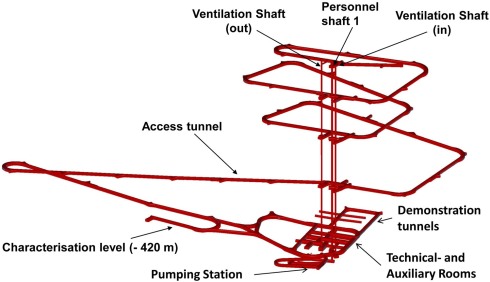
Onkalo Plan (http://www.posiva.fi/en/research_development/onkalo/)
Very few decisions can be made in the space of uncertainty, but countries like Finland have a protocol for operating in this darkness. The logic speak of the general logic under catastrophies, like fires in buildings: retardant. The project provides a series of strategies that would delay human discovery and intervention in the future. That darkness, though, cannot be simply maintained materially (which can easily be made to be self sustaining); it must also be buttressed by an intentional obfuscation of information. Darkness in this way takes more enery than light.
The [Recovering Berlin] competition is officially closed, thank you everyone for submitting your designs. The proposals were very diverse and there were alot of really interesting ideas. We kicked off the jury today with a discussion at Columbia University GSAPP with Mark Collins of Proxy, Geoff Manaugh of BLDGBLOG and Ed Keller of aum. It was a really productive conversation and exposed alot of the issues addressed by the entries. Since we have a number of jurers responding remotely, we will keep the conversation going over the weekend and choose winners Sunday night. We have put edited clips from the discussion on the “Video” page, as well as all the entries on the “Competition Entries” page for the jurors to consider. We will post the winners Monday morning.
All submissions must take the form of one (1) 8.5″ x 11″ image, landscape format TIFF at 300 dpi. Each proposal should be sent to protocol.architecture@gmail.com along with an e-mail stating which of the (3) protocol types were used, and which of the (5) project issues the proposal addresses (check the Competition Brief for detailed descriptions). Applicants may submit more than one submission, but each should be sent in a separate e-mail.
5 project issues: Institutional Identity, Programmatic Conflict (Security/Public Space), Program Temporality, Monumentality/Physical Permanence, Site (Berlin Identity).
3 protocol types: Designer/Technology (Scripts/Software), Person/Public (Codes/Legal Frameworks), Public/Technology (Biological Feedback/Digital Interfaces)
The EU HQ project is a seed for reconstituting the politics and economy of matter in Berlin. It reinterprets the built environment and the rebuilt environment.
Bacillus pasteurii is a “microorganism, readily available in marshes and wetlands, [that] solidifies loose sand into sandstone.” Check out a BLDG BLOG post about a proposal for the Sahara desert here.
“The structure is made straight from the dunescape by flushing a particular bacteria through the loose sand… which causes a biological reaction whereby the sand turns into sandstone; the initial reactions are finished within 24 hours, though it would take about a week to saturate the sand enough to make the structure habitable. The project – a kind of bio-architectural test-landscape – would thus go from a balloon-like pneumatic structure filled with bacillus pasteurii, which would then be released into the sand and allowed to solidify the same into a permacultural architecture.”
The final result can also be imagined by observing Tafoni stone formations, even though in this case it’s erosion rather than aggregation that’s taking place. There’s some of this stone in Germany, actually.
-yb

